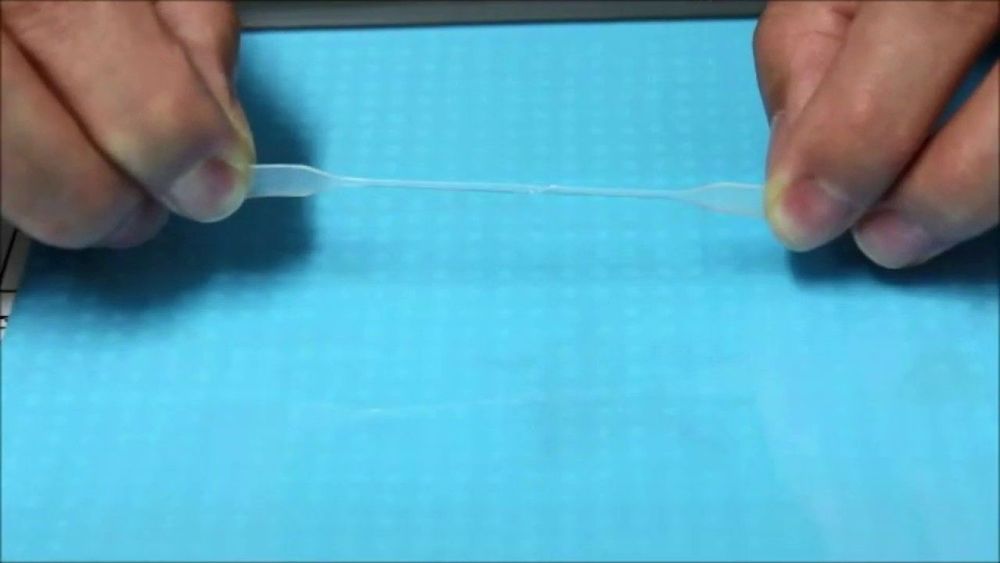Jun 18, 2019
Satellites show 740 square kilometres of rainforest cleared in 30 days
Posted by Fyodor Rouge in category: satellites
The bulldozing of the Amazon rainforest has risen sharply since Brazilian President Jair Bolsonaro came to power.
The bulldozing of the Amazon rainforest has risen sharply since Brazilian President Jair Bolsonaro came to power.

A research group from RIKEN and Kyushu University has developed a new type of material, based on ethylene, which exhibits a number of useful properties such as self-healing and shape memory. Remarkably, some of the materials can spontaneously self-heal even in water or acidic and alkali solutions. The new material is based on ethylene, a compound that is the source of much of the plastic in use today.
Materials that can self-heal have become a popular area of research during the last decade, and a variety of materials have been developed. However, most of the self-healing materials reported to date have relied on sophisticated designs that incorporate chemical mechanisms into polymer networks, such as irreversible or reversible covalent-bond formation, hydrogen bonding, metal-ligand interactions, or ionic interactions. As a result, they require some external stimulus, such as heat or pressure, to prompt them to heal, and in most cases, they do not function in water, acid or alkaline solutions because the chemical networks cannot survive such conditions. The ideal is to create a material that possesses sufficient toughness and can autonomously self-heal under various conditions.
Continue reading “Scientists discover new type of self-healing material” »
Ever wonder why some fortunate people eat chips, don’t exercise, and still don’t get clogged arteries? It could be because they’ve got lucky genes.
Now Alphabet (Google’s parent company) is bankrolling a startup company that plans to use gene editing to spread fortunate DNA variations with “one-time” injections of the gene-editing tool CRISPR.
Heart doctors involved say the DNA-tweaking injections could “confer lifelong protection” against heart disease.
![]()
In the spirit of ideas worth spreading, TEDx is a program of local, self-organized events that bring people together to share a TED-like experience. At a TEDx event, TEDTalks video and live speakers combine to spark deep discussion and connection in a small group. These local, self-organized events are branded TEDx, where x = independently organized TED event. The TED Conference provides general guidance for the TEDx program, but individual TEDx events are self-organized.* (*Subject to certain rules and regulations)
Captain Marvel is considered one of the top female superheroes of all time by many standards. Learn about her powers, how they work, and explore how sci-fi could become reality if CRISPR genome editing could create superhumans just like Captain Marvel.
Most nanoelectromechanical systems are formed by etching inorganic materials such as silicon. Kopperger et al. improved the precision of such machines by synthesizing a 25-nm-long arm defined by a DNA six-helix bundle connected to a 55 nm-by-55 nm DNA origami plate via flexible single-stranded scaffold crossovers (see the Perspective by Hogberg). When placed in a cross-shaped electrophoretic chamber, the arms could be driven at angular frequencies of up to 25 Hz and positioned to within 2.5 nm. The arm could be used to transport fluorophores and inorganic nanoparticles.
Science, this issue p. 296; see also p. 279
The use of dynamic, self-assembled DNA nanostructures in the context of nanorobotics requires fast and reliable actuation mechanisms. We therefore created a 55-nanometer–by–55-nanometer DNA-based molecular platform with an integrated robotic arm of length 25 nanometers, which can be extended to more than 400 nanometers and actuated with externally applied electrical fields. Precise, computer-controlled switching of the arm between arbitrary positions on the platform can be achieved within milliseconds, as demonstrated with single-pair Förster resonance energy transfer experiments and fluorescence microscopy. The arm can be used for electrically driven transport of molecules or nanoparticles over tens of nanometers, which is useful for the control of photonic and plasmonic processes. Application of piconewton forces by the robot arm is demonstrated in force-induced DNA duplex melting experiments.
This is where it gets a little weird.
When the team treated human cells in culture with extract of tardigrade, the GFP-tagged proteins stuck to human DNA just like they stick to tardigrade DNA, and cheerfully started doing what they do best: tamping down oxidative stress. When X-rays hit human cells, they do two kinds of damage. X-rays can cause direct DNA strand breaks, which are mostly single-strand. When they strike water molecules, they can also excite them into producing reactive oxygen species, which also cause single-strand breaks. High enough doses of X-rays can cause double-strand breaks. The damage-suppressing protein Dsup went immediately to work on the culture of human cells, suppressing or repairing single-strand and double-strand breaks by about 40%.
Clearly this means we can consume water bears to gain their powers. The study authors remark that the gene portfolio of the tardigrade represents “a treasury of genes” to improve or augment stress tolerance in other cells. Plug-and-play genetics, anyone?
Could an exotic super heavy element provide the key to humanity’s future in the stars? According to physicist Bob Lazar, “Element 115” is the fuel source for an alien spacecraft he was hired to reverse-engineer by the U.S. government—and if we can harness its awesome power, it will change our world forever.
Harvard and Japanese scientists say they’ve made a “landmark” discovery in cancer drug development. In a new study published Monday, they say they have finally found a way to synthesize in bulk a complex class of promising cancer-fighting molecules derived from sea sponges. Their new strategy has already helped speed up research into these molecules, including a planned clinical trial in humans.
Called halichondrins, the molecules were originally discovered by Japanese researchers in the mid-1980s in sea sponges. It became quickly apparent that they were capable of aggressively fighting tumors in both mice and lab dishes containing human cells, and in a way different from other existing treatments.
